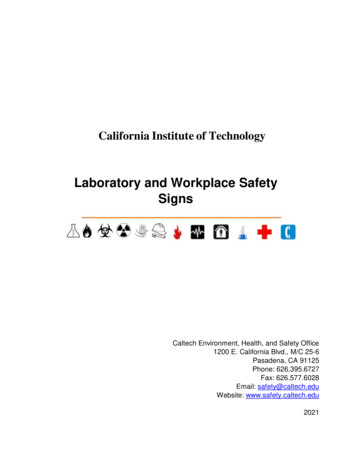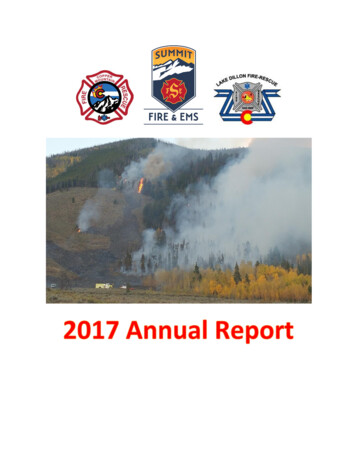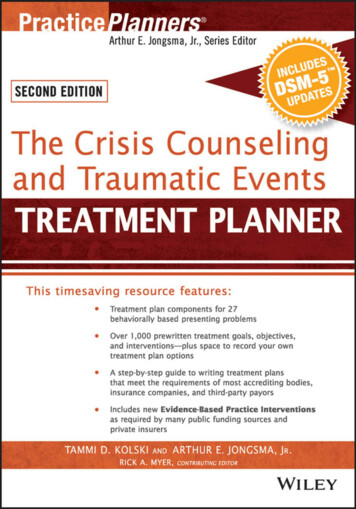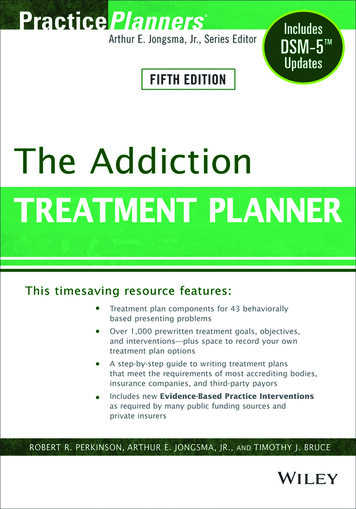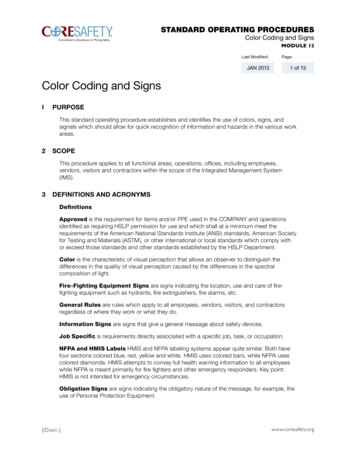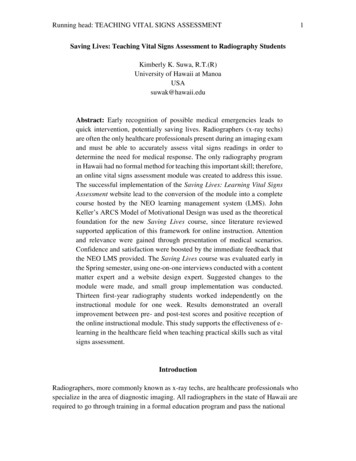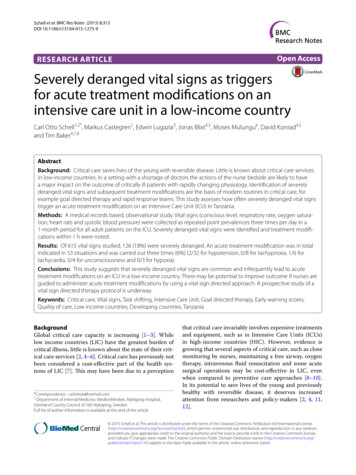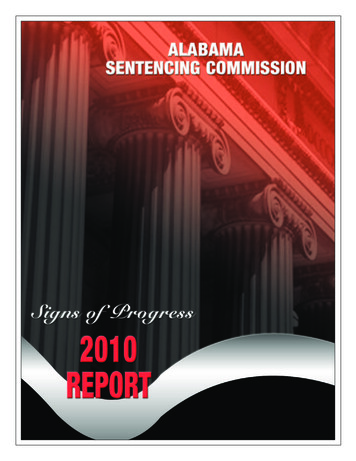
Transcription
ALABAMASENTENCINGCOMMISSION2010 ReportSigns of Progress300 Dexter AvenueSuite 2-230Montgomery, Alabama 36104Phone: (334) 954-50951-866-954-9411 ext.5095Fax: (334) 954-5201E-mail: sentencing.commission@alacourt.govWebsite: http://sentencingcommission.alacourt.gov
ALABAMA SENTENCING COMMISSION, 2010
Table of ContentsAcknowledgementsAlabama Sentencing Commission MembersExecutive Committee MembersAdvisory Council MembersCommission StaffStandards Committee MembersLegislative Committee MembersUniform Sentencing Order Committee MembersCooperative Community Alternative Sentencing ProjectState Steering Committee MembersiiiiiiiiiivivvviviiiLetter from ChairExecutive SummaryYear in ReviewI. History and OverviewII. Achievements & Signs of ProgressA. Improvements in Data and Data Systems from which to EvaluateAlabama’s Criminal Justice SystemB. A Fair, Effective and Efficient Sentencing System - Implementation ofInitial Voluntary Sentencing StandardsC. Sentencing Practices Before and After Implementation of the SentencingStandardsD. Creating a Wider Array of Sentencing Options1. Community Corrections Programs2. Drug Courts3. Alabama Board of Pardons and Paroles4. Cooperative Community Alternative Sentencing ProjectE. Substance Abuse Treatment and Reentry Programs1. ADOC Substance Abuse Programs2. Reentry Programsa. ADOC ReStart SAP Program – Technical Violators(Parole)b. ADOC Institutional Pre-Release and Reentry Programsc. Alabama Pardons and Paroles – LIFE Tech Transition FacilitiesF. ADOC Medical and Geriatric ReleaseIII. Sentencing Commission’s 2010 Legislative PackageA. Modifications to Existing Sentencing Standards, Worksheets andInstructionsB. Amendments to Community Punishment and Corrections ActC. Amendments to Split Sentence and Probation Revocation StatutesIV. Unified Judicial System Bill Supported by the Sentencing CommissionAlabama Drug Offender Accountability Act of 2010V. Recommendations of the Alabama Sentencing Commissionxixiiixv13AppendicesA) Achievements and Signs of ProgressB) Sentencing Standards - Sentencing Practices Before & AfterC) Community Corrections Programs and Drug Courts - Lists of Programs and MapsD) ADOC Substance Abuse ProgramsE) 2009 Crime Bills335891011131515161617181920202121222224
ALABAMA SENTENCING COMMISSION, 2010
AcknowledgementsIn recognition of the assistance and support provided to the Alabama Sentencing Commission by the variouscriminal justice agencies and departments and state and local officials, the Sentencing Commission takes thisopportunity to acknowledge and thank each one for their contributions and determination to improve Alabama’sCriminal Justice System. Successes based on recommendations of the Sentencing Commission have onlybeen accomplished due to their invaluable and consistent service and efforts. The extraordinary collaborationand coordination which exists between the Executive, Legislative, and Judicial branches for ways to improvesentencing and correctional practices have resulted in a united and coordinated effort to bring about sentencingreform and address the persistent problem of overcrowding in our prisons and jails.This nonpartisan cooperation and collaboration among all branches of government is consistent with theSentencing Commission’s determination to involve representatives from every part of the criminal justicesystem in its decision making process. In addition to the members of the Sentencing Commission and AdvisoryBoard, which are governed by statute, additional groups and individuals, have been appointed as AdvisoryBoard members or for service on one of the Sentencing Commission’s various committees. These members,representing crime victims, legislators, the bench and bar and criminal justice agencies and departmentsenable the Sentencing Commission to receive valuable input from those directly affected by the sentencingdecision.The Sentencing Commission and staff extend our sincere appreciation for the continuing assistance that hasbeen provided by these individuals to assist in our efforts to improve Alabama’s Criminal Justice System.Special recognition is extended to the following individuals and organizations for lending their knowledge,expertise and assistance to this crucial undertaking.Chief Justice Sue Bell CobbJoseph A. Colquitt, Chairman of the Sentencing CommissionJudges of the Court of Criminal AppealsAlabama Circuit and District Judges’ AssociationsGovernor Bob Riley and staffTroy King, Attorney GeneralThe Alabama Board of Pardons and Paroles and staff: Cynthia Dillard, Eddie Cook, and Robert OaksCommissioner Richard Allen, Alabama Department of CorrectionsVernon Barnett, Chief Deputy Commissioner of the Alabama Department of CorrectionsAdministrative Office of Courts and Alabama Judicial CollegeCallie Dietz, as Administrative Director of CourtsVictim Advocates, VOCAL, MADD, Angel House, Coalition Against Domestic ViolenceLegislative Reading and Research ServiceDr. Tammy Meredith and Dr. John Speir, Applied Research ServicesThe National Association of Sentencing Commissions and NASC Executive BoardVera Institute of Justice and Pew Charitable TrustsThe Crime and Justice InstituteAlabama Association of Community CorrectionsBecki Goggins, Criminal Justice Information CenterAlabama Lawyer’s AssociationThe Criminal Defense Lawyers AssociationFaulkner University and Dr. Lou HarrisCircuit Judge Mark Craig and Retired Judge Philip Reich, District Attorney Jim Osborn, Lawrence CountyCommission and local agencies participating as a CCASP Pilot SiteCircuit Judges Charles Price and Gene Reese, District Attorney Ellen Brooks, Montgomery County Commissionand local agencies participating as a CCASP Pilot Sitei
Alabama SentencingCommission MembersAppointed by the Chief Justice of the Supreme CourtRetired Circuit Judge Joseph A. Colquitt, ChairBeasley Professor of Law, University of Alabama School of LawGovernor’s AppointmentsVernon Barnett, Chief Deputy CommissionerAlabama Department of CorrectionsMiriam Shehane, Executive DirectorVictims of Crime and Leniency (VOCAL)Victims’ AdvocateJoe Faulk, CommissionerElmore County CommissionAttorney General AppointmentRosa Davis, EsquireChief Assistant Attorney GeneralPresident of the Alabama District Attorneys’ AssociationAppointmentEleanor I. Brooks, District Attorney, 15th Judicial CircuitPresident of the Alabama Association of Circuit CourtJudges’ AppointmentsP.B. McLauchlin, 33rd Judicial CircuitDavid A. Rains, 9th Judicial CircuitPresident of the Alabama Association of District CourtJudges’ AppointmentTerri Bozeman-Lovell, Lowndes CountyChair of the House of the Judiciary CommitteeRepresentative Marcel Black, 3rd District, Colbert CountyChair of the Senate Judiciary CommitteeSenator Myron Penn, 28th DistrictAlabama Department of CorrectionsRichard Allen, CommissionerAlabama Board of Pardons and Paroles’ AppointmentCynthia Dillard, Executive DirectorAppointment by the Chief Justice of the Supreme CourtLou Harris, D.P.A., Faulkner UniversityPresident of the Alabama Lawyers’ Association AppointmentJoe Reed, Jr., Esquire, Montgomery, ALPresident of the Alabama Criminal Defense Lawyers’Association AppointmentJoel Sogol, Esquire, Tuscaloosa, ALALABAMA SENTENCING COMMISSION, 2010ii
Executive CommiteeRetired Circuit Judge Joseph A. ColquittBeasley Professor of Law, University of Alabama School of LawRosa Davis, EsquireChief Assistant Attorney GeneralAdvisory CouncilCircuit Judge John W. Cole10th Judicial CircuitEddie Cook, Associate DirectorAlabama Board of Pardons and ParolesDoris DeaseVictim AdvocateDenis DevaneShepherd’s FoldLee Blank, ChiefClanton Police DepartmentKent Hunt, Associate CommissionerAlabama Department of Mental Health and Mental RetardationRepresentative John F. KnightAlabama House of RepresentativesShelly Linderman, Project DirectorVictims of Crime and Leniency (VOCAL)Retired Justice Hugh MaddoxAlabama Supreme CourtJ. Christopher Murphy, DirectorAlabama Department of Public SafetySheriff Wally OlsonDale County Sheriff’s OfficeDavid Horn, PresidentAlabama Community Corrections AssociationDirector, Shelby County Community CorrectionsMary Pons, Staff AttorneyAssociation of County CommissionsChaplin Adolph SouthTuscaloosa, ALWalter Wood, Executive DirectorAlabama Department of Youth ServicesJeff Williams, DirectorCommunity Corrections Division, Alabama Department of Correctionsiii
Commission StaffLynda Flynt, Executive DirectorRosa Davis, Chief Assistant Attorney GeneralMelisa Morrison, Research AnalystPaul Sullivan, Sentencing Worksheets SpecialistBennet Wright, StatisticianStandards CommitteeRosa Davis, ChairChief Assistant Attorney GeneralEleanor I. Brooks, District Attorney15th Judicial CircuitCynthia Dillard, Executive DirectorAlabama Board of Pardons and ParolesBecki GogginsCriminal Justice Information CenterRandy Hillman, Executive DirectorAlabama District Attorneys’ AssociationShelly Linderman, Project DirectorVictims of Crime and Leniency (VOCAL)Circuit Judge P. B. McLauchlin33rd Judicial CircuitCircuit Judge David A. Rains9th Judicial CircuitJoe Reed, Jr., EsquireMontgomery, ALMiriam Shehane, Executive DirectorVictims of Crime and Leniency (VOCAL)Tommy Smith, District Attorney6th Judicial CircuitJoel Sogol, EsquireTuscaloosa, ALCircuit Judge Malcolm Street, Jr.7th Judicial CircuitCircuit Judge Virginia Vinson10th Judicial Circuit - BirminghamMitzie WheatVictims of Crime and Leniency (VOCAL)ALABAMA SENTENCING COMMISSION, 2010iv
Bob Williams, Public DefenderShelby CountyEddie Cook, Associate DirectorAlabama Board of Pardons and ParolesKathy Eades Daniel, Deputy District Attorney10th Judicial CircuitDoris DeaseVictim’s AdvocateBrandon Falls, District Attorney10th Judicial CircuitLynda Flynt, Executive DirectorAlabama Sentencing CommissionRalph HendrixUAB Treatment Alternatives to Street Crime (TASC)Bob Johnston, Assistant District Attorney9th Judicial CircuitTommy Spina, EsquireBirmingham, ALLegislative CommitteeLou Harris, D.P.A., ChairFaulkner UniversityNick Abbett, District Attorney37th Judicial CircuitVernon Barnett, Chief Deputy CommissionerAlabama Department of CorrectionsSharon Bivens, Legislative Fiscal AnalystLegislative Fiscal OfficeRepresentative Marcel Black, ChairHouse Judiciary CommitteeEleanor I. Brooks, District Attorney15th Judicial CircuitPresiding Circuit Judge John B. Bush19th Judicial CircuitRosa Davis, EsquireChief Assistant Attorney GeneralCynthia Dillard, Executive DirectorBoard of Pardons and ParolesLynda Flynt, Executive DirectorAlabama Sentencing Commissionv
Beck GogginsCriminal Justice Information CenterRalph HendrixUAB Treatment Alternatives to Street Crime (TASC)Retired Circuit Judge Robert M. HarperHaygood, Cleveland, Pierce, Mattson & ThompsonLee CountyCircuit Judge James E. Hill30th Judicial CircuitKent Hunt, Associate CommissionerAlabama Department of Mental Health and Mental RetardationRepresentative John F. KnightAlabama House of RepresentativesKim Martin, General CounselCrimes Victims Compensation CommissionSenator Myron Penn, ChairSenate Judiciary CommitteeMarty Ramsay, DirectorCourt Services Division, Administrative Office of CourtsJoe Reed, Jr., EsquireMontgomery, ALMiriam Shehane, Executive DirectorVictims of Crime and Leniency (VOCAL)Mary Pons, Staff AttorneyAssociation of County CommissionsStacey Neeley, DirectorDeKalb County Community Punishment & Corrections Authority, Inc.Eddie Cook, Associate DirectorAlabama Board of Pardons and ParolesUniform Sentencing OrderCommitteeCircuit Judge Virginia A. Vinson, Chair10th Judicial Circuit - BirminghamNick Abbett, District Attorney37th Judicial CircuitAnne Adams, Special CounselAlabama Department of CorrectionsEleanor I. Brooks, District Attorney15th Judicial CircuitALABAMA SENTENCING COMMISSION, 2010vi
Foster Cook, DirectorUAB Treatment Alternatives to Street Crime (TASC)Rosa Davis, EsquireChief Assistant Attorney GeneralCircuit Judge Scott Donaldson6th Judicial CircuitBrandon Falls, District Attorney10th Judicial Circuit - JeffersonLynda Flynt, Executive DirectorAlabama Sentencing CommissionGreg Gambril, District Attorney22nd Judicial CircuitKathy Holt, DirectorCentral Records Division, Alabama Department of CorrectionsCorinne Hurst, Circuit ClerkLee CountyBob Johnston, Assistant District Attorney9th Judicial CircuitCircuit Judge P.B. McLauchlin33rd Judicial CircuitMelissa Rittenour, Circuit ClerkMontgomery CountyJoel Sogol, EsquireTuscaloosa, ALCircuit Judge David Rains9th Judicial CircuitBob Williams, Public DefenderShelby CountyJeff Williams, DirectorCommunity Corrections Division, Alabama Department of CorrectionsNathan Wilson, Staff AttorneyAdministrative Office of Courtsvii
Cooperative CommunityAlternative SentencingProject(CCASP)Chief Justice Sue Bell Cobb, Co-ChairSupreme Court of AlabamaRosa Davis, Co-ChairChief Assistant Attorney GeneralState Steering CommitteeLindsey Allison, County CommissionerShelby CountyVernon Barnett, Chief Deputy CommissionerAlabama Department of CorrectionsArt Baylor, Chief of PoliceMontgomery Police DepartmentDistrict Judge Michael Bellamy26th Judicial CircuitRepresentative Barbara Boyd32nd District, Calhoun and Talladega CountiesSonny Brasfield, Executive DirectorAssociation of County CommissionsEleanor I. Brooks, District Attorney15th Judicial CircuitFoster Cook, DirectorUAB Treatment Alternatives to Street Crime (TASC)Deborah DanielsPrison Fellowship MinistriesCynthia Dillard, Executive DirectorBoard of Pardons and ParolesCircuit Judge Clark Hall16th Judicial CircuitKent Hunt, Associate CommissionerAlabama Department of Mental Health and Mental RetardationDavid Horn, PresidentAlabama Community Corrections AssociationDirector, Shelby County Community CorrectionsRetired District Judge Orson “Pete” JohnsonChief Justice’s Drug Court Task ForceRebecca Johnson, Deputy DirectorMontgomery County Community Corrections ProgramLee Knowles, EsquireGeneva CountyALABAMA SENTENCING COMMISSION, 2010viii
Stacy Neely, DirectorDeKalb County Community Punishment & Corrections Authority, Inc.Judy Newcomb, District Attorney28th Judicial CircuitMarty Ramsay, DirectorCourt Services Division, Administrative Office of CourtsRetired Circuit Judge Philip Reich, II36th Judicial CircuitMiriam Shehane, Executive DirectorVictims of Crime and Leniency (VOCAL)Jeff Williams, DirectorCommunity Corrections Division, Alabama Department of CorrectionsRev. Jiles Williams, County CommissionerMontgomery Countyix
Mission StatementThe Alabama Sentencing Commission shall work to establish and maintainan effective, fair, and efficient sentencing system for Alabama that enhancespublic safety, provides truth-in-sentencing, avoids unwarranted disparity,retains meaningful judicial discretion, recognizes the most efficient andeffective use of correctional resources, and provides a meaningful array ofsentencing options.ALABAMA SENTENCING COMMISSION, 2010x
ALABAMA SENTENCING COMMISSION300 Dexter AvenueMontgomery, Alabama 36104-3741(334) 954-5095FAX: (334) 954-5201Website - http://sentencingcommission.alacourt.govJanuary 12, 2010Joseph A. Colquitt, ChairmanBeasley Professor of LawVernon Barnett, Esq.Chief Deputy CommissionerDepartment of CorrectionsHon. Marcel BlackState RepresentativeHon. Terri Bozeman-LovellDistrict JudgeHon. Eleanor I. BrooksDistrict AttorneyRichard F. AllenCommissionerDepartment of CorrectionsRosa Davis, Esq.Chief Assistant Attorney GeneralCynthia S. DillardDirectorBoard of Pardons and ParolesMiriam ShehaneDirector, VOCALVictims’ AdvocateDr. Lou M. Harris, Jr.Faulkner UniversityHon. P. B. McLauchlin, Jr.Circuit JudgeJoe FaulkCounty CommissionerElmore CountyHon. David A. RainsCircuit JudgeJoe Reed, Jr., Esq.AttorneyHon. Myron PennChair, Senate Judiciary CommitteeSenatorJoel SogolAttorneyHonorable Bob Riley, Governor of AlabamaHonorable Sue Bell Cobb, Chief Justice of the Alabama Supreme CourtHonorable Troy King, Attorney General, State of AlabamaThe Honorable Members of the Alabama SenateThe Honorable Members of the Alabama House of RepresentativesThe Honorable Members of the Judicial Study CommissionThe Citizens of AlabamaSection 12-25-33 of the Code of Alabama requires the Alabama Sentencing Commission to reportupon its work and recommendations annually. In compliance with this statutory obligation, onbehalf of the Commission members and staff, I respectfully submit for your review the 2010Report of the Alabama Sentencing Commission.The 2010 report, “Signs of Progress,” compliments last year’s report which contained the firstcompliance results of the initial sentencing standards. This year’s report provides a comparativeanalysis of the sentencing practices for worksheet offenses before the sentencing standards wereimplemented, with sentences imposed after the standards became effective on October 1, 2006.Through this comparison it is shown that the sentencing standards have had a positive impact onsentencing practices, with judges more often utilizing alternatives to incarceration for non-violentoffenders and reserving long prison terms for violent felons committing personal offenses. Thereport also includes a summary of the achievements of the Commission during FY 2009 as well assince the Sentencing Commission began its work in 2001.Because this report provides only a summary of the major accomplishments of the SentencingCommission, I encourage you to visit our website: http://sentencingcommission.alacourt.gov fora more comprehensive review of our successes and the progress made by the other departmentsand agencies that have been active participants in improving Alabama’s Criminal Justice System.The Commission members and staff greatly appreciate the support and encouragement that havebeen provided toward achieving our goals and objectives and the commitment for advancementthat has been demonstrated by our State’s leaders. A special thanks is extended to Chief JusticeCobb for her achievements in the expansion of drug courts, her active participation as co-chair ofthe CCASP project to improve community supervision, and her steadfast support for the work ofthe Sentencing Commission.The Alabama Sentencing Commission is hosting the National Association of SentencingCommissions’ 2010 Annual Conference August 8th-10th in Point Clear, Alabama. This is a rareopportunity to have prominent and highly respected criminal justice experts visit our state andshare information and their experiences on sentencing policies and criminal justice matters. TheNASC Annual Conference is always a valuable learning experience, bringing together judges,legislators, policy makers, academics, researchers, correctional officials and practitioners fromaround the country to examine sentencing laws and practices, examine other states’ experienceswith sentencing laws and practices and discuss emerging issues and innovative ways to addressescalating prison and jail populations. We are honored that Alabama has been selected as a conferencesite for 2010 and hope that you will plan to attend this informative and useful conference.Sincerely,Lynda Flynt, Esq.Executive DirectorJoseph A. Colquitt, ChairAlabama Sentencing Commissionxi
ALABAMA SENTENCING COMMISSION, 2010xii
Executive SummarySigns of ProgressThe Alabama Sentencing Commission dedicates this report to the leadersof our State who continue to struggle with the problems of Alabama’sCriminal Justice System and, despite limited resources, push ahead andmake improvements. While advances may have been small ones, whencombined with the progressive changes undertaken by others, the overalleffect has been impressive. Special recognition is extended to Chief JusticeSue Bell Cobb for her work in the expansion of drug courts and improvementof community supervision services, to Commissioner Richard Allen for hispersistent determination to improve Alabama’s prison system, and to CynthiaDillard and the Board of Pardons and Paroles for acting on new andinnovative approaches to change criminal behavior. Special appreciation isextended to these officials for their consistent efforts to improve Alabama’sCriminal Justice System.Among the Legislative mandates contained in the Commission’s enablingact was the study of Alabama’s Criminal Justice System and the charge tomake recommendations that could address prison crowding and create awider array of sentencing options, while maintaining meaningful judicialdiscretion and protecting public safety. The Commission chose to addressthese mandates by encouraging use of alternative sentencing options fornon-violent offenders to make room in the prisons for violent and seriousoffenders. The Commission has pursued these goals in two ways:(1) drafting and adopting the initial voluntary sentencing standards that wereapproved by the Legislature in 2006 and which became effective on October1, 2006; and (2) providing recommendations and assistance in establishinga wider array of intermediate punishment options. These two approacheshave been successful in changing sentencing practices to redirect nonviolent offenders to a wider array of intermediate punishment options andaddressing criminal behavior by targeting specific conduct through treatmentand community supervision.This year’s report focuses on achievements that have been made inAlabama’s Criminal Justice System that grew out of recommendations madeby the Sentencing Commission. There is particular emphasis on the impactof the voluntary sentencing standards since they were implemented threeyears ago and growth of intermediate punishment options.The Commission’s analysis of sentencing practices before and after theimplementation of the initial voluntary sentencing standards, demonstratesthat the standards are influencing sentencing decisions to divert a largerpercentage of non-violent offenders from prison with no decrease in thepercentage of more violent offenders receiving incarceration. The analysisshows the standards are working to increase the use of alternative sentencingoptions for nonviolent offenders and to reserve scarce prison beds for moreviolent offenders.xiii
Executive SummaryDrug and property standards offenses, which are tracked and reportedannually by the Sentencing Commission, account for 69% of all convictions.Since adoption and implementation of the sentencing standards, there hasbeen a marked decrease in the percentage of offenders convicted of theseoffenses sentenced to serve time in the penitentiary, with five of the drugand property worksheet offenses registering double digit percentage pointdrops. These declines are examined in detail in Appendix B. For each ofthe 26 sentencing standards offenses information is provided on convictions,prison admissions, and prison sentences imposed for first time offendersfor the three years prior to implementation of the standards (2004-2006)and for the two years following implementation of the standards ( 2007 and2008). There have been significant decreases in the use of prison for firsttime offenders for property and drug worksheet offenses.Intermediate punishment options are now more available than before theSentencing Commission was established and began makingrecommendations for the expansion of alternative punishment and treatmentprograms. These options, initially recommended by the Commission, includedrug courts, community corrections programs, transitions centers (LIFETech) for men and women, and a technical violator center for probationersand parolees on the verge of returning to prison. These options and othersundertaken by the Department of Corrections and the Board of Pardonsand Paroles have resulted in over 3,000 otherwise prison bound offenderseither remaining in the community or being referred to other intermediatepunishment options. These programs have been successful in providingjudges with a wider array of sentencing options.The Commission is now engaged in a pilot project, the CooperativeCommunity Alternative Sentencing Project (CCASP), whose goal is tocontinue to increase and improve alternative sentencing options by providinga true continuum of graduated punishment in four pilot jurisdictions, using acommittee of local stakeholders to determine the best options for eachjurisdiction, ultimately using evidence-based practices to accomplish changesin criminal behavior. The pilot jurisdictions are testing a comprehensiverisk and needs assessment system that could greatly benefit the criminaljustice system by determining the risk of offending for each convictedoffender and suggesting the dynamic factors present for each offenderthat, if changed, can lower the risk. Lowering the risk of reoffending, ofcourse, increases public safety. By identifying those whose behavior canbe changed by addressing needs, and identifying those needs, the criminaljustice system can target those offenders most likely to change and identifythe services needed to accomplish those changes. The use of the risk andneeds assessment system would thereby allow the State to more specificallytarget the best use of its scarce resources.Much is left to be done. These difficult economic times require that theAlabama Sentencing Commission and all components of our State’s criminaljustice system continue to analyze our criminal laws and sentencing practicesand seek additional ways to improve the system.ALABAMA SENTENCING COMMISSION, 2010xiv
Year in ReviewMeetingsThe Sentencing CommissionThe Sentencing Commission and Advisory Council held its quarterly meetingsduring FY2009 and CY2009 on December 5, 2008, January 16, 2009, May15, 2009, September 11, 2009 and November 6, 2009. The LegislativeCommittee of the Sentencing Commission, chaired by Dr. Lou Harris, metthree times: October 9, 2008, August 25, 2009, and October 20, 2009. TheStandards Committee, chaired by Rosa Davis, also met three times:November 7, 2008, August 13, 2009, and October 16, 2009. The UniformSentencing Order Committee, chaired by Circuit Judge Virginia Vinson,met six times: June 9, 2009, July 10, 2009, August 14, 2009, September 8,2009, October 15, 2009, and December 10, 2009.With technical assistance provided by the Vera Institute of Justice and theCrime and Justice Institute, several meetings were held to pursue the goalsof the Cooperative Community Alternative Sentencing Project (CCASP).This project, aimed at improving the services available through thecommunity to offenders that are returning from prison or diverted fromprison and being supervised in the community, is one for which Alabama isreceiving technical assistance through a grant provided by Pew CharitableTrusts.Commission & CommitteeMeetingsCooperative CommunityAlternative SentencingProjectDuring 2009 there were 14 meetings involving the CCASP StatewideSteering Committee, the Pilot Site Selection Committee and local meetingsin the pilot sites of Lawrence and Montgomery Counties. In addition therewere 12 meetings devoted to selection, training, and proper implementationof a Uniform Risk/Needs Assessment Instrument.Sentencing Standards Worksheet Training and Sentencing EntriesDuring 2009 the Sentencing Commission staff has continued to conducteducational workshops on completion of the worksheets and use of thesentencing standards to encourage utilization of the standards and alternativesentences for eligible offenders. In addition to manning a helpline forquestions on the sentencing standards and worksheets, additional trainingwas provided in Tuscaloosa, Jefferson, Montgomery and Baldwin Counties.Individual meetings were also held with Presiding Circuit Judges in circuitswith low compliance rates.Educational Training onSentencing StandardsThe Sentencing Commission plans to continue its efforts to improve thereliability of sentencing information entered into the court system’s database,realizing that it is essential to establish and implement a uniform procedurefor the entry of sentences. Reduced staff and insufficient funding havedelayed the educational efforts for court specialists this year.Other Criminal Justice ActivitiesSentencing Commission staff participated on various boards and committeesand made presentations to various criminal justice groups. A substantialamount of time was spent this year on the Cooperative Communityxv
Year in ReviewASC Commission & StaffServe on NumerousCriminal Justice Boards &CommitteesAlternative Sentencing Project, co-chaired by Chief Justice Cobb and ChiefAssistant Attorney General Rosa Davis. In addition, staff served on theJudicial Study Commission (JSC), the JSC’s Consolidation of SupervisionServices Committee, the Pro’s and Con’s Subcommittee of the Committeeon Consolidation of Supervision of Services, the Chief Justice’s Drug CourtTask Force and the Legislative Committee of that Task Force. TheCommission’s Director also served as a member of the VOCAL Board,the Supreme Court’s Advisory Committee on Criminal Procedure, theAlabama Association of Community Corrections, the UJS Judicial StudyCommission (JSC), the Court Clerk’s Advisory Committee of the JSC, theState Bar Warrant and Indictment Manual Committee, the Alabama LawInstitute (ALI), Criminal Code Revision Committee, and as secretary onthe Executive Board of the National Association of Sentencing Commissions.Commission members and staff attended and/or made presentations toseveral criminal justice groups this year including: the Jefferson Countyprobation officers, circuit and district judges, court specialists, county barassociations, the Legislative Commission on Women and Girls in the CriminalJustice System, the Alabama Association of Community Corrections, theCriminal Code Revision Committee, and the Association of CountyCommissions.Technical AssistanceCCASP Initiated in TwoPilot SitesAlabama to Host NASC2010 ConferenceVera Institute of Justice, Crime and Justice Institute and PewCharitable TrustsContinuing a project begun in 2007, with grant funding from Pew CharitableTrusts, the Vera Institute of Justice (Vera), joined by the Crime and JusticeInstitut
E. Substance Abuse Treatment and Reentry Programs 1. ADOC Substance Abuse Programs 2. Reentry Programs a. ADOC ReStart SAP Program - Technical Violators (Parole) b. ADOC Institutional Pre-Release and Reentry Programs c. Alabama Pardons and Paroles - LIFE Tech Transition Facilities F. ADOC Medical and Geriatric Release III.

